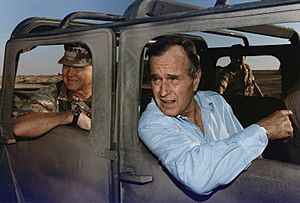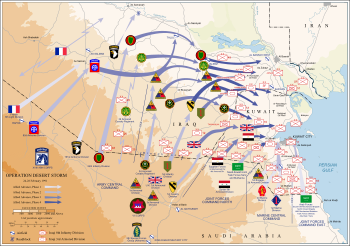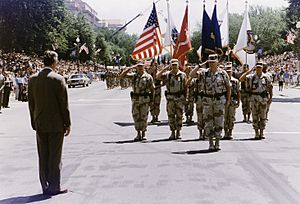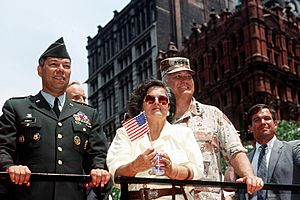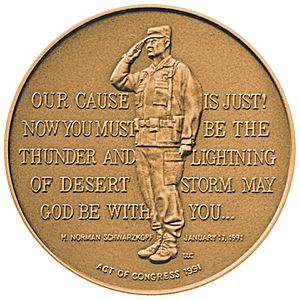Norman Schwarzkopf Jr. facts for kids
Quick facts for kids
General
Norman Schwarzkopf
|
|
|---|---|
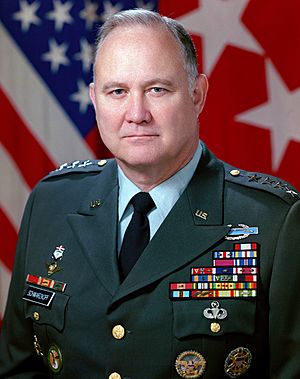
Official portrait, 1988
|
|
| Birth name | Herbert Norman Schwarzkopf Jr. |
| Nickname(s) |
|
| Born | August 22, 1934 Trenton, New Jersey, U.S. |
| Died | December 27, 2012 (aged 78) Tampa, Florida, U.S. |
| Buried |
West Point Cemetery, New York, U.S.
|
| Service/ |
United States Army |
| Years of service | 1956–1991 |
| Rank | General |
| Commands held |
|
| Battles/wars |
|
| Awards |
|
| Alma mater | United States Military Academy (BS) University of Southern California (MEng) |
| Spouse(s) |
Brenda Holsinger
(m. 1968) |
| Children | 3 |
| Relations | Norman Schwarzkopf Sr. |
| Signature | |
Herbert Norman Schwarzkopf Jr. (born August 22, 1934 – died December 27, 2012) was a highly respected United States Army general. He is best known for leading all the international forces during the Gulf War in 1991. This war successfully removed Iraqi troops from Kuwait.
Born in Trenton, New Jersey, Schwarzkopf spent parts of his childhood in the United States and Iran. He attended the United States Military Academy at West Point. After graduating, he became a second lieutenant in the U.S. Army in 1956. He served in the Vietnam War as an adviser and later as a commander. He received many awards for his bravery, including three Silver Stars and two Purple Hearts.
After Vietnam, he continued to rise through the ranks. He commanded the 24th Mechanized Infantry Division and helped lead the United States invasion of Grenada in 1983. In 1988, he took command of United States Central Command (CENTCOM). This role put him in charge of U.S. military operations in many countries.
When Iraq invaded Kuwait in 1990, General Schwarzkopf was tasked with responding. He planned and led Operation Desert Storm. This operation involved a huge air campaign followed by a quick ground attack. It successfully defeated the Iraqi Army in early 1991. After the war, Schwarzkopf retired and focused on helping others. He passed away in 2012 from complications of pneumonia.
Contents
Early Life and Education
Norman Schwarzkopf Jr. was born on August 22, 1934, in Trenton, New Jersey. His father, Norman Schwarzkopf Sr., was a military academy graduate and a veteran of World War I. His mother, Ruth Alice Bowman, was a housewife. Norman's father later became the first leader of the New Jersey State Police.
As a child, Norman was active and athletic. He was very close to his father. When he was eight, his father rejoined the military during World War II. This made family life challenging. At age 10, Norman took an official photo with a serious look. He said he wanted people to know he was serious when he became a general.
In 1946, when Norman was 12, he moved to Tehran, Iran, with his father. There, he learned to shoot, ride horses, and hunt. He developed a lasting interest in Middle Eastern culture. The family later moved to Geneva, Switzerland, in 1947. Norman also visited other European cities with his father. He returned to the United States in 1951. From a young age, Norman wanted to be a military officer, just like his father.
He attended several schools, including ones in Tehran, Geneva, and Germany. He graduated from Valley Forge Military Academy in 1952. He then went to the United States Military Academy at West Point. There, he played football, wrestled, and sang in the choir. His large size helped him in sports. He graduated in 1956 with a science degree. Later, he earned a master's degree in engineering from the University of Southern California.
Military Career Highlights
Starting as a Junior Officer
After West Point, Schwarzkopf joined the Army as an infantry second lieutenant. He completed his basic training and earned his Parachutist Badge. His first job was leading a platoon in the 101st Airborne Division in Kentucky. He noticed problems with military leadership early on.
He was promoted to first lieutenant in 1958. In 1959, he went to West Germany for his first overseas assignment. He worked as a staff officer and platoon leader. In 1960, he became an aide-de-camp to a general in West Berlin.
Schwarzkopf became a captain in 1961. He then attended advanced infantry training. In 1962, he studied missile mechanics at the University of Southern California. He earned a master's degree in engineering in 1964. He then taught at West Point for a year. He volunteered for duty in South Vietnam to advance his career faster.
Serving in the Vietnam War
In Vietnam, Schwarzkopf advised the Army of the Republic of Vietnam (ARVN) Airborne Division. He became a major soon after arriving. He experienced his first combat on August 3, 1965. He advised South Vietnamese paratroopers trying to help a trapped force. The fighting was intense, and Schwarzkopf bravely helped wounded soldiers under heavy fire. For his leadership, he received the Silver Star.
On February 14, 1966, Schwarzkopf led an attack on enemy forces. He was wounded four times by gunfire. But he refused to leave or give up command until the mission was complete. He earned a second Silver Star and a Purple Heart for this.
After ten months, he returned to West Point to finish his teaching duties. In 1968, he attended the Army's Command and General Staff College. During this time, he met Brenda Holsinger, a flight attendant. They married in 1968 and later had three children.
In 1969, Schwarzkopf was promoted to lieutenant colonel. He returned to Vietnam for a second tour. This time, he was an executive officer at the main U.S. military headquarters. He later took command of a battalion, the 1st Battalion, 6th Infantry. He found his troops were not motivated and had discipline problems.
Schwarzkopf was known for his strong leadership. He pushed his troops to patrol more and fight the enemy. He often led from the front, avoiding safer areas. He was wounded a second time during this tour. He risked his life to help soldiers trapped in a minefield. For this, he received a third Silver Star and a second Purple Heart. He also earned three Bronze Star Medals. His experiences in Vietnam made him cautious about future wars.
Rising to General Officer
After Vietnam, Schwarzkopf thought about leaving the military. But he decided to stay to help fix problems he saw. He had surgery for back problems made worse by parachute jumps.
Between 1970 and 1983, he held many different jobs. He became a colonel and served in Alaska. In 1976, he commanded a brigade in Washington state. He was very successful in improving his unit's readiness. He was then promoted to brigadier general.
In 1978, he worked in Hawaii. He then spent two years in Germany with the 8th Infantry Division. He returned to Washington, D.C., and was promoted to major general. In 1983, he became the commanding general of the 24th Infantry Division in Georgia. He made training very tough and was known for his strict style.
Leading in Grenada
On October 25, 1983, Schwarzkopf helped lead the United States invasion of Grenada. He was the main Army adviser for the operation. The mission had many problems, like poor communication between different military branches. Schwarzkopf was named deputy commander at the last minute.
He helped with the first landings. He even helped settle a disagreement between Army and Marine commanders. He flew into Grenada on the second day. Though he initially doubted the mission, he later saw it as a success. It showed the strength of the U.S. military after Vietnam. The operation taught him the importance of different military branches working together. He later pushed for more joint operations.
Becoming CENTCOM Commander
In July 1985, Schwarzkopf worked at the Pentagon. On July 1, 1986, he became a lieutenant general. He commanded I Corps at Fort Lewis. He then returned to the Pentagon in 1987. He also served on the Military Staff Committee at the United Nations Security Council. This helped him develop diplomatic skills.
In November 1988, Schwarzkopf became the commander of United States Central Command (CENTCOM). He was chosen because he was a good thinker and knew a lot about the Middle East. He was promoted to general. CENTCOM was responsible for U.S. military operations in 19 countries. Schwarzkopf changed the focus of CENTCOM. He worried more about threats from countries like Iraq than from the Soviet Union.
He started planning for a possible Iraqi invasion of Kuwait. In early 1990, he created a war plan called "Defense of the Arabian Peninsula." It imagined Iraq invading Saudi Arabia through Kuwait. In July 1990, he ran a military exercise that was very similar to what happened next. One week later, Iraq invaded Kuwait on August 2, 1990.
The Gulf War
Schwarzkopf was surprised when Iraq captured Kuwait City. He feared Iraq would invade Saudi Arabia next. He immediately put defense plans into action. He then met with U.S. President George H. W. Bush. His war game plan became the basis for a counterattack. On August 5, Bush decided on a strong response. Schwarzkopf went with Secretary of Defense Dick Cheney to meet with Saudi King Fahd. They convinced the King to allow U.S. troops into Saudi Arabia.
On August 7, Bush ordered troops to Saudi Arabia. Their first job was to defend Saudi Arabia. U.S. commanders wanted a quick, powerful fight, not a slow build-up like in Vietnam. Schwarzkopf especially wanted to avoid the mistakes of Vietnam. His plan for overwhelming force was initially criticized. But by August 13, the news media began covering Schwarzkopf, who was chosen to lead the operation.
Operation Desert Shield
From his headquarters in Florida, Schwarzkopf began planning to defend Saudi Arabia. He planned supply lines for the 50,000 troops sent to Saudi Arabia. By August 20, 20,000 U.S. troops were there, with 80,000 more preparing to deploy. Schwarzkopf arrived in Saudi Arabia on August 25. He often visited the troops and spoke with reporters.
He worked to coordinate forces from many different countries. By mid-October, he felt confident that the forces could defend Saudi Arabia. He also worked to help foreign troops adjust to life in Saudi Arabia. On December 29, 1990, he was told to be ready to attack Iraq and Kuwait by January 17.
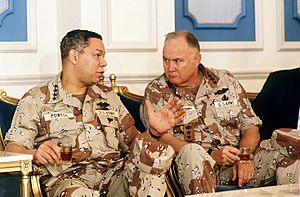
The first part of the operation, called "Desert Shield," involved stopping ships from Iraq at sea. As more troops arrived, Schwarzkopf planned an attack against Iraqi forces. He worked long hours with his team. He often talked with General Colin Powell, the Chairman of the Joint Chiefs of Staff.
Schwarzkopf's plan, "Operation Desert Storm," used overwhelming force. It combined strong infantry attacks with artillery and tanks. By November 8, President Bush agreed to send 400,000 U.S. troops. Schwarzkopf believed more troops would mean fewer casualties. He planned a huge bombing campaign before the ground attack. This would hit Iraqi forces and their supply lines. Diplomatic efforts failed, and the deadline for Iraq to leave Kuwait passed.
By then, Schwarzkopf commanded 750,000 troops from many nations. This included 500,000 U.S. troops. Most of these troops were not combat veterans. Schwarzkopf wanted to fight carefully to keep casualties low. His experience in the Middle East helped him work well with allied commanders. He had a good relationship with Saudi commander Khalid bin Sultan. This helped him gain support from the Saudi people.
Operation Desert Storm
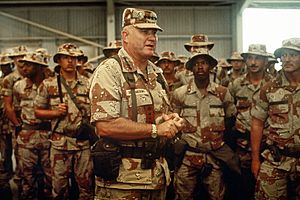
The air campaign against Iraq began on January 17, 1991. Schwarzkopf watched the strikes from his command center. He told the press that the air war was going "exactly as we had intended." He gave frequent updates to the media.
The air campaign was very successful. It gave the coalition control of the air. It also destroyed Iraq's communication networks, supplies, and many tanks. By January 20, he announced that Iraq's nuclear reactors were destroyed. By January 27, he said the coalition had total air control. Over 38 days, the Air Force destroyed a large part of Iraq's ground forces. President Bush then gave Iraqi leader Saddam Hussein an ultimatum: leave Kuwait by February 23, or the ground forces would attack.
Schwarzkopf began the ground campaign on February 24. Saudi-led forces attacked Kuwait City. Two U.S. Marine divisions attacked oil fields. Other U.S. forces quickly moved to cut off Iraqi troops from the west. This plan became known as his "Left Hook" strategy. Schwarzkopf expected the war to last weeks. He also expected chemical weapon attacks, but they did not happen. Iraqi resistance was weaker than expected, and many Iraqi soldiers surrendered.
Within 90 hours, his forces had defeated many Iraqi divisions. The cost in American lives was low. He ordered his forces to destroy as much Iraqi equipment as possible. This was to weaken Iraq's ability to fight in the future. The conflict was sometimes called "The Hundred Hour War."
Schwarzkopf had ordered a media blackout during the ground attack. He finally spoke to journalists on February 27 to explain his strategy. On March 3, he went to Kuwait City to negotiate a ceasefire with Iraqi military leaders. They also worked out the return of prisoners of war. After this, he oversaw the return of U.S. troops.
For his service, Schwarzkopf was welcomed back to America as a hero. He received many honors, including a large parade in New York. He became the only person to receive the Distinguished Service Medal from the Army, Navy, Air Force, and Coast Guard. He was praised much differently than commanders from past wars. He became a national celebrity. He was quick to praise his troops, which he saw as restoring pride in the U.S. armed forces after Vietnam.
Later Life and Retirement
After the Gulf War, Schwarzkopf returned to the U.S. as a national hero. He was good at dealing with the press, which helped his public image. He wanted to retire from the military in mid-1991. He was offered a higher position but declined. He was also asked about running for political office but was not interested. He retired in August 1991 and moved to Tampa, Florida.
After retiring, Schwarzkopf became a celebrity. He was praised by many news outlets. His speaking fees were very high. In 1992, he published his memoir, It Doesn't Take a Hero, which became a bestseller.
In 1993, Schwarzkopf was treated for prostate cancer and recovered. He received many awards, including the Presidential Medal of Freedom in 2002. Queen Elizabeth II also made him an honorary knight. He supported several children's charities and worked to raise awareness for prostate cancer. He also served on the board of The Nature Conservancy. He generally lived a quiet retirement in Tampa.
In 2002, he helped create an educational video game about asthma called Quest for the Code. He also voiced a character in the game.
Schwarzkopf had mixed feelings about the 2003 invasion of Iraq. He initially supported it after Colin Powell's presentation to the United Nations. But when no weapons of mass destruction were found, he changed his mind. He criticized the lack of a plan for rebuilding Iraq after the war. He felt the initial plans did not consider Iraq's culture. In 2004, he criticized Donald Rumsfeld for how he handled Operation Iraqi Freedom.
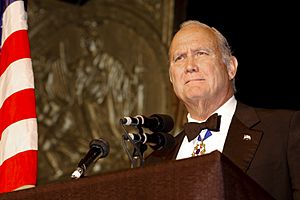
Schwarzkopf supported George W. Bush in the 2000 and 2004 presidential elections. He supported John McCain in 2008. He was often encouraged to run for political office but showed no interest.
His Death
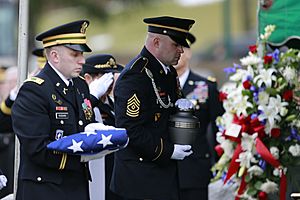
Norman Schwarzkopf died on December 27, 2012, at age 78. He passed away from complications after a fight with pneumonia. A memorial service was held at West Point on February 28, 2013. Many important people attended, including Colin Powell. Schwarzkopf was cremated, and his ashes were buried near his father's at the West Point Cemetery.
Many people shared their thoughts after his death. Former President George H. W. Bush said Schwarzkopf "epitomized the 'duty, service, country' creed." President Barack Obama said Schwarzkopf "stood tall for the country and Army he loved." The Secretary of the Army and Army Chief of Staff said the nation owed him "a great debt of gratitude."
His Legacy
Leadership Style
During his time in Vietnam, Schwarzkopf became known as a commander who led from the front. He was even willing to risk his own life for his soldiers. His leadership style focused on being prepared, disciplined, and training hard. But he also made sure his troops could enjoy some comforts. He told West Point cadets that competence and good character were very important.
He was known for getting angry easily with staff officers who were unprepared. He was even more upset with other generals he felt were not aggressive enough. His short temper was well known. Some people criticized his leadership style, saying it limited their creativity. However, many saw him as an exceptional leader.
Gulf War Leadership
The quick victory in the Gulf War was largely credited to Schwarzkopf's leadership. President Bush said the war showed the importance of air power. Historian Rick Atkinson called Schwarzkopf "the most theatrical American in uniform since Douglas MacArthur." Atkinson believed Schwarzkopf led one of the greatest military campaigns ever.
Some historians, however, criticized Schwarzkopf's ceasefire agreement. They said it allowed Iraq to keep flying armed helicopters. This allowed Iraq to later attack its own people. Schwarzkopf later wrote that invading all of Iraq would have been a mistake. He said the U.S. would have had to pay to rebuild the entire country.
Schwarzkopf wanted to change how journalists and the military worked together. He felt negative media coverage had hurt troops in Vietnam. During the Gulf War, he allowed more media coverage but kept strict controls on the battlefield. He held regular briefings for journalists. He believed extensive press coverage would build public support for the war and boost morale. He also showed off advanced U.S. military technology. This helped distract the public from focusing on casualties.
Awards and Decorations
Schwarzkopf received many military awards:
|
|
||||||||||||||||||||||||||||||||||||||||||||||||||||||||||||||||||||||
| U.S. Non-Military and Foreign Military Personal Awards and Decorations | |
|
|
|
Other Honors and Recognition
- Congressional Gold Medal, 1991.
- United States Republican Senatorial Medal of Freedom
- Schwarzkopf Elementary School, named after him in Lutz, Florida, 1991.
- Honorary First-Class Private in the French Foreign Legion, 1991.
- Golden Plate Award of the American Academy of Achievement, 1991.
- Distinguished German-American of the Year, 2006.
- Inducted in the New Jersey Hall of Fame, 2008.
- Time magazine cover on February 4, 1991, and April 1, 1996.
- A ski trail at Telluride Ski Resort was renamed "Stormin' Normin" in 2012.
Images for kids
See also
 In Spanish: Norman Schwarzkopf para niños
In Spanish: Norman Schwarzkopf para niños


